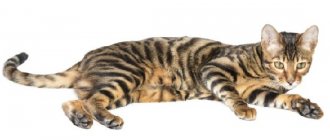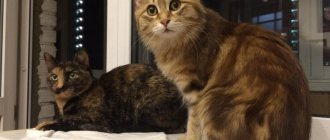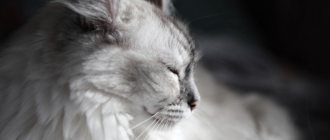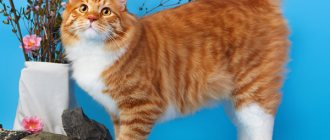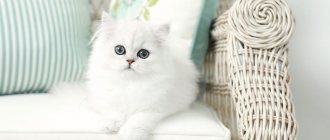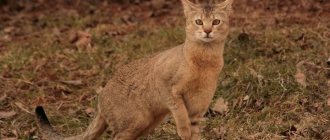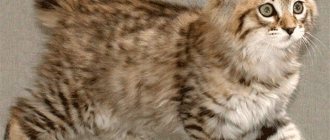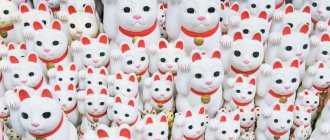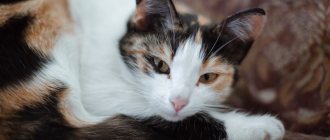International felinological organizations have registered about three hundred cat breeds to date. Some of them arose from ancient natural species, others are the result of mutation and selection work.
Each type of cat requires specific care and conditions. Therefore, they approach the choice of a pet responsibly. There are rare breeds of cats that stand out not only for their beauty, but also for their cost.
Chartreuse
If you are looking for an unusual cat with an exotic appearance and a sweet disposition, you should consider the Carthusian cats. The breed originated in France in the 16th century, but the breed's origins are a matter of debate. One widely accepted theory is that the Chartreux descended from cats brought to France by Carthusian monks. Another theory is that the breed originated from wild cats native to modern-day Syria, brought to France by returning crusaders.
The breed has always been rare, and after the Second World War it almost became extinct, and the existence of wild specimens was not known for a long time. However, through the efforts of breeders, this cat breed was saved, although to this day it remains exotic. Because of this, chartreuse kittens typically cost between $1,000 and $1,500, depending on age, pedigree and other factors.
Carthusian cats are immediately recognizable by their thick gray-blue fur, bright orange-gold eyes, cute round faces and dense body with short legs. They are sometimes called "toothpick potatoes." Males usually weigh from 4.5 to 6.4 kg, females are smaller - from 2.7 to 4.1 kg. Chartreuse fur is multi-layered and waterproof, sometimes having the appearance of fleecy wool. Due to the special structure of the facial bone, Chartreux dogs often appear to be “smiling.”
Despite their strong and dense build, Carthusian cats can be quite agile. They have super-fast reflexes and are excellent mousecatchers. The breed is also famous for its gentleness, warmth and calm temperament. Cats get along well with both children and other pets. This is an excellent breed for apartments; they will not wake up neighbors with loud meows at night; it is not for nothing that they are called “silent monks.”
This is a slow growing breed that reaches adult size in three to five years. As they mature, Carthusian cats' coats become woolier in texture. Chartreuse is quite easy to care for. Its thick, short coat is resistant to shedding. A cat's undercoat sheds twice a year, but its neat appearance can be easily maintained with regular brushing.
California radiant
These rare cats are the result of painstaking selection work. Breeders have been crossing different cat breeds for over 10 years to achieve the desired result. The breeders wanted to get a cat that would look like a leopard. The result of this work was the emergence of a new breed - the Californian radiant.
Exotic Californians are incredibly energetic, playful and friendly. They need a lot of time and space to realize their natural activity. Owners need to come to terms with the fact that cats will poke their noses everywhere they can and cannot, hunt, climb and jump. To prevent this activity from becoming destructive, you need to take care of a multi-level play complex for the cat.
Price
In Russia and Ukraine it is difficult to purchase this breed. The cost of kittens is from 500 to 2000 US dollars.
Don Sphynx
This special breed was first spotted in Rostov-on-Don in 1986. City resident Elena Kovaleva took away a mangy kitten from schoolchildren, which they were mocking. As she aged, the cat Varvara lost her remaining hair. Crossing her with a European shorthair cat led to the appearance of hairless offspring, which became the founder of the new breed “Don Sphynx”. The International Cat Association officially recognized this unique breed in 2005.
Although the Don Sphynx is similar in appearance and structure to ordinary Sphynxes, it is very distinctive and is not easily mistaken for representatives of other breeds. The Don Sphynx is a medium-sized cat with long legs, a muscular body structure, a small wedge-shaped head, large ears and characteristic webbed toes. The hairlessness of the breed requires special attention, since, despite the lack of maintenance required, the skin of the Don Sphynx is very similar to human skin and requires regular bathing. Being hairless, Don Sphynxes are sensitive to temperature, so they need warm clothing in the winter months and sunscreen in the summer.
Breeders and owners described Don Sphynx cats as even-tempered cats with an affectionate and inquisitive nature. They benefit from both physical and mental exercise. Tolerant of children and other pets, Don Sphynx cats display calm behavior most of the time, without being overly shy or aggressive. Otherwise the breed is active and very sociable. On average, a healthy adult cat will weigh 3.6-4.5 kg with a life expectancy of approximately 12-15 years.
Bombay
If you do not take into account the calm, patient and friendly nature of the Bombay, you might think that he is a miniature copy of the black panther. The breed's exotic appearance was achieved by crossing a sable Burmese cat with a black American Shorthair, earning it the nickname "the patent leather baby with the new penny eyes."
Korat
The Korat is an affectionate cat with a royal bearing and a magnificent sparkling blue coat. This is one of the oldest breeds in the world. In their native Thailand they are revered as “lucky cats.” The Korat is considered a symbol of prosperity, which is why these cats are traditionally given to brides as a wedding gift. Until the mid-20th century, Korats were never sold, they were only given as gifts. Korats with a corrugated or striped tail were considered especially lucky.
The first mention of Korats was found in the Treatise on Cats, compiled around 1350. The book describes 17 breeds of “lucky cats,” including Korats. The breed has changed very little over almost eight centuries.
Korats have one of the most beautiful coats in the entire cat kingdom. They only come in one color: a beautiful blue with a silver tint that gives them a shimmering, halo-like appearance. They are a small to medium-sized breed with low body fat, large forward-facing ears, and round green eyes.
Korats are sometimes called the "cat with five hearts" because, in addition to the heart beating in their chest, their heads have a distinctive valentine shape when viewed from the front or from above. Their noses are also heart-shaped, and a fifth "heart" can be seen on their pectoral musculature, just between their front shoulders.
This is a very smart cat and a caring member of the family. Korats are calmer than most cat breeds. They will find time to both play and “hugging” their owner. Korats form strong, deep bonds with the one or two people they spend the most time with. They are either afraid of strangers or simply ignore them. Korats are not particularly fond of sharing, and fights with other animals can break out over a favorite ball or toy. They are very sociable pets, so they do not like to spend long periods of time alone. The cat will happily accompany its beloved family members around the house all day.
The Korat is an easily adaptable and unpretentious animal. The cat doesn't tend to shed much hair, making it a "tolerant" choice for people with cat hair allergies. Korats do not require much grooming. Their shimmering coat requires light brushing once a week.
Khao-mani
The breed is ancient, but quite rare. Having such a cat in your home is considered great luck. The breed received its second name Diamond Eye (diamond eye) for the beautiful color of the iris. The eyes of these cats are blue, green, amber and multi-colored. Snow-white pets with eyes of different colors look especially impressive.
Kao-mani are friendly, social animals. For a happy life, they vitally need communication with their own kind. The owners of such a pet must take care of other pets with whom the cats will spend time. Cats have a hard time with loneliness and without company they become depressed and aggressive.
Price
There are no breed nurseries in Russia and Ukraine. You can buy a kitten abroad or from private breeders. The cost of kittens starts from 80,000 rubles.
Likoy
The mutation that gave Lykoi his werewolf appearance was a natural process of crossbreeding between feral cats over many years. In 2011, breeders Patti Thomas and Johnny Gobble produced their first litter of werewolf kittens. Some Lykoi are still born in wild colonies. The name "Lykoi" is a variation of the Greek word "Lycos", meaning "wolf". All current domestic specimens of this breed can trace their ancestry back to wild ancestors. Until now, the Likoi is considered an extremely rare breed of cat; there are less than 100 show-standard specimens in the world.
The Lykoy, also sometimes called the "wolf cat," is certainly one of the most visually unique cat breeds in the world. Despite their wild appearance, they are friendly, affectionate, playful pets that get along with people and other animals.
This medium-sized cat has a thin, fit body, a wedge-shaped head with a hairless "mask" of skin around the eyes, nose, muzzle and back of the ears. Some Lykoi are even completely bald. Because of this, they are often confused with sphinxes, although there is no genetic connection between them.
The coat of the Lykoi is thin, short and relatively soft, although it appears harsh in appearance. Standard colored cats have roan coats with a slightly silvery tint. Instead of an undercoat, they only have fine top hairs, which can make them look mangy. The cat's eyes are almost round, amber or green.
This breed is friendly and flexible. The behavior of Lykoi cats is generally quite playful, although they will wander off on their own from time to time. They are open to strangers, but can seem somewhat aloof as they prefer the company of their regular human companions.
Their thin coat provides little protection from cold or direct sunlight, so to keep your Lykoi healthy and happy, it is recommended that you keep him exclusively as an indoor cat. Despite its relatively short coat, the Lykoy is not considered a hypoallergenic breed. They sometimes shed even more than the typical domestic shorthair cat.
The rarest breed
Today, the rarest is the Dragon Li or Li Hua. This is a Chinese breed, very ancient and exotic, but it received official recognition in the world only recently.
Chinese felinologists believe that this breed was formed naturally as a result of a mutation of the Chinese mountain cat. So far, the variety has been registered only in not very recognized organizations - the American ACFA system and the CAA of China.
This is a strong animal, characterized by high adaptability and survival, very similar to ordinary street strays. The color can be either solid of any color or striped tabby. This animal is valued for its high intellectual level, intelligence and excellent mutual understanding with humans.
Nibelung
Nibelungs are beautiful, loving, loyal cats who enjoy stability and routine. This rare cat breed, developed in the United States in the 1980s, is prized for its long, soft coat and calm nature.
In 1984, a long-haired blue kitten was born into the litter of breeder Cora Cobb from Colorado. His parents were a domestic short-haired cat and a long-haired male that resembled a black angora. The kitten, named Siegfried, was the only blue longhair in the litter. The following year, the same couple produced a second blue longhair cat named Brünnhilde. It was these two kittens that became the basis of the Nibelung breed.
The Nibelung has a long, graceful neck, a wedge-shaped head and medium-sized ears. Its almond-shaped eyes are almost always bright green, although there are varieties of the breed with yellow-green eyes. The Nibelung's coat is grey-blue in color with silver tips, especially around the head and neck, giving the fur a slightly shimmering appearance. A thicker tuft of hair frames the neck, which is more pronounced in males. The fur on their tails is longer than on their bodies, and both males and females have ruffled fur between their toes.
The Nibelung can make an excellent pet for older people, largely due to its relatively reserved and easy-going nature. They are quite capable of entertaining themselves during the day, but they are not averse to sitting quietly next to their favorite people. If you are a person who sticks to a certain daily routine, the Nibelung will fit perfectly into your life. This breed loves routine. Any changes to their environment or life pattern can cause short-term stress as cats take their time to adapt. Because of their quiet nature, Nibelungs tolerate long periods of solitude well. Separation anxiety is rarely a problem for them, especially if they maintain a regular eating schedule and have easy access to their favorite toys and litter box.
Nibelungs thrive in different temperatures and do not require much physical activity. However, their long coat requires quite frequent brushing, probably two to three times a week, otherwise it will not be neat and clean. Representatives of this breed live from 11 to 18 years.
Savannah
The second rarest breed, a hybrid of a domestic cat and a serval.
This is a very beautiful and impressive breed. Cats have developed intelligence.
They are large, graceful, love water and require activity.
This article will tell you why other cats are afraid of water.
Peterbald
Similar in size and appearance to the Sphynx or Oriental Shorthair, the Peterbald is a new breed of Russian origin with a unique coat and a loyal family disposition. The first recognized Peterbald appeared in St. Petersburg at the end of 1994 as a result of an experimental crossing of a female Don Sphynx and a male Oriental Shorthair. For this reason, straight-haired Peterbalds are sometimes mistaken for Siamese cats and completely hairless ones for Sphynx cats, although the Peterbald is now a genetically distinct cat breed.
The baldness gene is dominant in Peterbalds, so when crossed with other cats, hairless kittens are more often obtained. This breed is rare, so it costs accordingly. A Peterbald kitten can cost up to $2,000.
The Peterbald can have a variety of coat colors and patterns: a short coat of coarse guard hairs with a slight bend, a thin velor fluff or complete absence of hair - the cat can go through all these stages throughout its life. Hairless Peterbald kittens may grow fur, but straight-haired kittens will lose it within the first two years of life. It is noteworthy that in multi-colored Peterbalds, the coat sometimes consists of two completely different types of hair: the light parts are soft, and the dark parts are harsher.
The Peterbald is a medium-sized cat with a long, lean body, a dense belly, and a typically wedge-shaped head. The ears are comical looking oversized large triangles with a slightly rounded shape. Their large, almost almond-shaped eyes usually have a greenish tint. The tail is long and flexible.
This is an incredibly affectionate, playful and deeply loyal family cat breed that develops strong bonds with people of all ages and enjoys the company of other animals. However, play with other pets and small children should be at least passively supervised, as bare skin makes the Peterbald more susceptible to scratches and cuts, which should be promptly disinfected and cleaned. Feeding Peterbalds can sometimes be a difficult problem. They have a higher than average metabolism, so some owners feed their pets up to five times a day. Even with plenty of food, Peterbalds do not gain much weight. Body weight varies from 3.2 to 6.35 kg. The lifespan of Peterbalds ranges from 12 to 15 years.
6.Chausie
The name of the breed comes from the Latin name of the jungle cat felis chaus, which lives in Africa and South Asia in swampy areas near rivers and lakes. Chausie is a tall, long-legged, lithe cat with an athletic build suitable for running and jumping. She has high-set, straight ears, sometimes with tufts at the tips, slightly drooping eyelids, yellow or green eyes, and gentle brown fur. The weight of adults is from 7 to 11 kg. The Chausie breed was created by crossing a jungle cat and a domestic cat. Jungle cats, or swamp lynxes, were domesticated and highly revered by the ancient Egyptians for their easy temperament and hunting skills. There have been many cases of marsh lynx mating with domestic species, but the first breeding was registered in 1990. Chausies are very smart, good-natured, and affectionate. They are active, playful, form close bonds with family members and do not like to be alone. They are bred in Europe and North America; purebred individuals are rare.
Raas
This endemic breed of domestic cat was named after the Indonesian island of Raas, their place of origin. Almost all Raas cats live on their native island, only a few individuals have been sent from Indonesia to other countries around the world, where they are kept as pets.
The exotic beauty and rarity of the breed makes them especially attractive to cat lovers. Unfortunately, Raas have a strong and independent character, so they do not always get along with their owners. If you decide to get a kitten of this breed, treat it with respect and do not try to dominate it.
Raas evolved in solitude, without interbreeding with other cat breeds. This gave them several notable traits similar to lynxes. You can identify cats of this breed by their square faces, slightly pointed chins, triangular ears and oval-shaped dark green eyes. The body size is larger than the average domestic cat. The tail is curved at the end.
Cats come in a wide variety of colors. Many even have multiple colors, like regular house cats. Some of the most elegant cats boast a dark black color with a blue tint.
Rare and expensive
List of the most expensive (cost in dollars):
- Laperm - three hundred to two thousand;
- Serengeti - six hundred to two thousand;
- Elf - six hundred to two thousand;
- Kao-Mani - seven to ten thousand;
- Savannah - from twenty-two to one hundred thousand.
Also read the article about the most expensive cat breeds.
The cost of a rare pet depends on its class, gender, and nursery. A PET-class kitten (without documents) will cost several times less than an individual from titled parents. The cost of females is usually higher than that of males. In foreign nurseries, animals are more expensive.
Read the article about the most beautiful cat breeds.
Sphinx
This cat breed can be unmistakably recognized by its natural hair loss. Sphynxes regularly appear on lists of the most affectionate cat breeds. This is also a relatively new cat breed. In 1966, a domestic shorthair cat in Canada gave birth to an almost hairless kitten named Prune. The cat's offspring were crossed with Devon Rexes in an attempt to create a completely hairless breed. It was originally called the "Canadian Hairless Cat" but was later changed to "Sphinx" due to its resemblance to cats in Egyptian hieroglyphs.
Sphinxes are not only a spectacular appearance, but also a friendly character. These comical cats are smart, charming, sociable and loyal. And this unusual breed costs a lot of money. A Sphynx kitten from a reputable breeder typically costs between $1,500 and $6,000, depending on the pedigree.
The Sphynx, although considered a “hairless cat,” is covered with a fine, hard-to-see down that is very soft to the touch. The cat's skin is often pigmented or patterned, like the traditional coat of other domestic breeds. Sphynxes have a wide variety of colors: chocolate, brown, sable, blue-gray, black, cream, beige, white, etc.
Distinctive features of the Sphynx are also lemon eyes, long fingers, huge ears and many visible wrinkles. Despite their round bellies, Sphynx cats are actually incredibly active animals with muscular bodies. They are considered a medium-sized cat and typically weigh between 2.7 and 6.3 kg.
Sphynxes are an active breed that needs a lot of physical and mental stimulation. These sociable animals do not do well when left alone. They get along well with children, the elderly, dogs and other cats. The lifespan of sphinxes is 9-15 years.
Burmilla
The Burmilla is a medium-sized cat with a muscular, elegant body. Its distinctive feature is its thick silvery coat with a silky sheen, against which its intelligent green eyes stand out. There are short-haired and semi-long-haired individuals. The history of the breed begins in 1981, when in Great Britain, as a result of an accidental mating of a lilac Burmese cat with a Persian chinchilla cat, four short-haired silver kittens were born. The name "Burmilla" comes from the parent species. Representatives of the species have a calm, balanced, inquisitive character. The mischievous nature of the Burmese, mixed with the lightness and ease of the Persian chinchilla, makes it sociable, playful and gentle.
Sufalak
The breed originated in Thailand almost three centuries ago. Its representatives are often confused with Havanese and Burmese cats. When the sufalak is exposed to the sun, its coat usually takes on a ruby hue, although in normal light it has a rich chocolate brown tint.
Sufalak cats have a medium-sized, muscular build, typical of oriental cats. They have wedge-shaped heads with piercing bright yellow/golden eyes. The whiskers are brown, complementing the color of the coat, and the skin of the nose is pinkish-brown. The paw pads are light brown with a pink tint.
Like other Thai cat breeds, the Suphalak is especially people-oriented. This is a moderately active and assertive cat breed that appreciates family company. Sufalak cats enjoy socializing. Affectionate by nature, they expect the same return from you. Sufalak is not very demanding of games and active activities, but cannot stand loneliness. His intelligence and communication skills are often compared to those of the smartest dog breeds. They say that the sufalak also has a “dog-like” character, because he loves to play hide and seek, walks and rides in the car.
Sufalak is an extremely rare breed of cat. To date, only one copper-chocolate sufalak has been exported from Thailand. Outside of Thailand, the Suphalak cat was first born in 2015.
Toyger
Toygers are true domestic tigers. True, they resemble wild animals only in appearance. These cats are strong, agile, and resilient. Their movements reveal effortless grace and softness. Their body is strong and muscular. The tail is an exact copy of a tiger's. The same low-set, thick and long.
Toygers are not called “toy tigers” for nothing. Their color should be expressive. The main coat color is usually dark brown. The fur on the belly is always lighter. The stripes can be bronze or black. Be sure to be vertical and contrasting to the main color.
Toygers have a wonderful character. They are sociable but unobtrusive. Calm, friendly and smart. Domestic tigers love active games and are not at all afraid of water. They also have a beautiful melodic voice.
Elf
These handsome guys are quite young. They were first seen in America in 2006. To get such hairless pets, breeders had to work hard. Curls and Sphynxes took part in the painstaking work.
In addition to the fact that cats do not have hair, they have rather unique ears. Friendliness, intelligence, mischief, sociability, and curiosity are the main features of these pets. Elves are not a cheap pleasure. They cost at least 2000 dollars.
Elves got their name because of the ears that resemble those of fairy-tale characters.
Laperm
These pets have a peculiar curly coat. Its appearance dates back to 1980, but they received their official calling in 1996. These cats love to hunt.
Curiosity, affection, activity are the main distinguishing features of these pets. They are invaluable companions for people with allergies. Laperm costs 200-2000 dollars.
Minuet
Minuet (minuet, also known as Napoleon in the past) was recognized by TICA in 2016. From this moment on, Minuettes were able to take part in exhibitions, but there are still very few breeders of the breed, and accordingly, it is not easy to obtain a kitten with the appropriate documents. Other organizations are still ignoring the breed.
The minuet appeared in the USA in the early 90s. Breeders crossed representatives of the Persian breed with a Munchkin. The experimenters wanted to get a mini-cat with a cute kitten face, a toy-cat. There was no goal to breed a short-legged individual. But to the delight of breeders, unusual short-legged cats were born.
There may be irony hidden in the original name of the breed. Emperor Napoleon was short. In addition, as historical sources testify, a cat scared him as a child, and subsequently, when he saw cats, Napoleon felt extreme discomfort, a kind of neurosis.
The key feature of this breed is its small size: the minuet is almost 2 times smaller than a regular cat, the average weight of representatives is only 2 kg.
This cat's coat can be plush and short, but there can also be long-haired variants reminiscent of Persian cats. The coat color is very varied. These tiny cats are a breeder's dream come true of having the cutest feline pets.
Minuet Napoleon - a tiny cat with a cute kitten face
Napoleons are kind, affectionate, and devoid of any aggression. But these little ones are also the most vulnerable of the felines. Future owners need to remember that the breed is intended exclusively for home keeping. Outside the house, due to their small size and absolute non-hostility, animals can die.
For a minuet kitten you will have to pay from 40 thousand rubles.
Scottish lop-eared
Interest in this cat primarily arises from its original ears, the shells of which are unusually and unusually bent forward. The Scots got this ear structure thanks to a mutation. The first such rare cat in the world was seen by people in 1961.
Her country of origin is Scotland. They have a lot of positive qualities. Cats are distinguished by their insightful mind, balance, and playfulness. They easily find a common language with everyone around them.
Their uniqueness is manifested in the originality of their voice. They do not purr or meow like most of their relatives. These sounds are more creaky. The owners of these pets are captivated and make them smile by their ability to stand on their hind legs.
They can stand on them for a long time, looking at what interests them. They are also distinguished by an interesting body position during rest. Cats sit with their back straight and their legs extended. This pose is called the Buddha pose. These cats can be purchased for $200-$1400.
Maine Coon
These amazing pets came to us from America. With their appearance, striped color and large fluffy tail, cats are very similar to raccoons, which is why the name contains the word kun, which translates as raccoon.
These heavyweights can gain weight from 5 to 15 kg, and grow more than a meter in length. But such huge parameters and a seemingly formidable appearance only seem so at first glance. In fact, it is difficult to find a more gentle and soft pet.
Compliance, affection, goodwill and playfulness are the main character traits of pets. Singing creatures bring incredible pleasure to those who hear them. Such a miracle is not cheap - from 600 to 1500 dollars.
A characteristic feature of Maine Coons is the tufts on their ears.
Devon – rex
Somewhat earlier, in 1960, short-haired cats with an unusual appearance were born in England, which immediately attracted attention. One can say about the body of pets that it is of a fragile structure covered with soft curled fur.
The huge ears of the Devon Rex are striking. Cats are so smart that they can quickly learn tricks that, due to their complexity, not all of their relatives can do.
Another important advantage of these furry four-legged friends is their hypoallergenicity, which is why their popularity is growing every day. buy such a rare domestic cat for $400-1200.
Ocicat
With a coat that can be spotted with tan, chocolate, bluish, lavender or tan and cinnamon, the Ocicat is quite an exotic breed. But there is nothing wild about these cats: the breed was the result of crossing Abyssinians, Siamese and American Shorthair cats.
